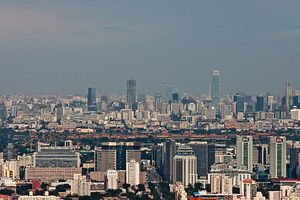China’s top planners have long dreamed of remaking the country’s capital region into an integrated, economic nerve center. But one of the first concrete steps toward that goal came late in November with the official announcement of a $36 billion high-speed rail plan to link Beijing, Tianjin, and a handful of cities in neighboring Hebei province.
The long-term strategy is to bring the three districts together into a contiguous megacity, often referred to as Jing-Jin-Ji (a Chinese portmanteau of their names). The resulting urban space would dwarf many mid-sized countries in terms of area, house well over 100 million people, and compete with China’s two other major economic regions around Shanghai and Hong Kong.
The idea has divided urban planners, among whom it has typically been received as either a looming logistical disaster or a thrilling test of what city planning can achieve on a large scale. But among economists, the plan has generally just stirred excitement.
One reason it has captured economists’ imagination is the curious emphasis it puts on industry and manufacturing — a throwback to China’s classic growth model. In recent years, a clear effort was underway to bring Beijing’s financial sector to a level on par with China’s more globally visible economic centers in the Pearl and Yangtze River Deltas, each of which boasts at least one international stock exchange. But this plan appears to shift away from that focus. Instead, leaders seem to be counting on the region’s comparative advantages in labor supply, industrial development, and instructional capital to transform it into a high-end manufacturing and technology hub.
In the Jing-Jin-Ji trinity, Beijing offers a huge variety of jobs, including in the country’s giant government apparatus and the many corporate headquarters that have flocked to China’s capital. It’s also an intellectual center with many of China’s top universities, and a great deal of talent in engineering and the sciences. Tianjin is a major port city through which a considerable share of the products made in northern China is shipped abroad. And for the most part, the outlying cities to the south in Hebei are either bedroom communities with large commuter populations, or industrial hotbeds with dense concentrations of steel, iron and concrete factories.
In putting the three areas within a 30-minute train ride of one another, leaders hope to build a more fluid labor market and encourage growth in strategic, forward-thinking sectors, and a strong case can be made that their plan is realistic. For instance, a 2015 report from the Paulson Institute argued that the region is well positioned to significantly build out its high-tech manufacturing, specializing in things like solar power and green building technologies.
Further, the cities in Hebei that will be folded into Jing-Jin-Ji have strong, but aging, manufacturing infrastructure. With China doing everything possible to cut overcapacity and rebalance the national economy, it needs to repurpose and upgrade factories, and absorb workers as industry contracts. So in many ways, Hebei is an ideal place to enact some of these reforms, and its proximity to Beijing should make it easy to retrain workers for higher-end manufacturing jobs.
In committing to a truly regional vision, leaders have also begun experimenting with the opposite strategy of pushing jobs out of big cities and into the suburbs. For example, beginning next year, much of Beijing’s municipal government operations will be relocated to offices in Tongzhou, outside the city center, and closer to Tianjin. So economists will also be watching how effectively this integrates the region, and how well it will scale, which could provide valuable lessons for economic policy elsewhere.
By most estimates, industry still counts for at least 40 percent of China’s GDP, and much of it is concentrated around smaller, inland cities. Additionally, many of these are satellite cities around one of China’s several megalopolises. So to some extent, what Jing-Jin-Ji will test is whether pooling resources across expansive metropolitan areas like these can bring better, more sustainable growth in the region as a whole. Or put more simply, are transportation links and initiatives that distribute jobs and talent enough to help China’s industrial cities transition to a more balanced economy heavy in services and clean industry?
The fact that Beijing is the centerpiece of this particular plan has left many analysts optimistic about its prospects. As a flagship project in the country’s capital, there are strong political motivations for making it a success. Every signal so far is that China’s top leadership is committed and willing to spend heavily to make sure everything works as planned.
The bigger question is how applicable it will be to other cities that may be populous and developed, but lack all the resources and prominence that Beijing has to offer. There are now dozens of cities with a population of at least 1 million in China, and dozens more in India, and elsewhere across Asia. Especially as population grows and urbanization continues, many of these cities will be in a position to merge with neighboring ones to form urban agglomerations that stretch the current definition of a city. Looking forward, Jing-Jin-Ji should be looked to as a test of whether these sorts of mergers are advisable.
Zach Montague is a newsroom assistant at The New York Times, and studies the economic and political forces shaping East Asia. He holds a degree in China & Asia Pacific Studies from Cornell University and has previously worked in Beijing, Xi’an, and Abu Dhabi. Follow him on Twitter @ZJMontague.

































